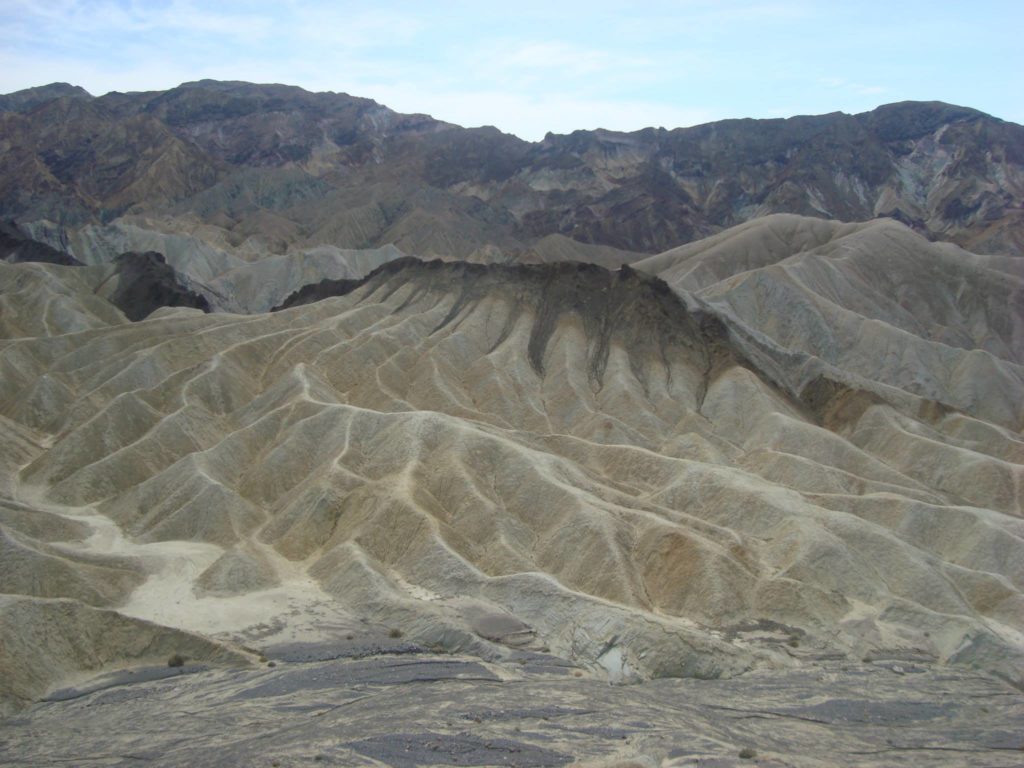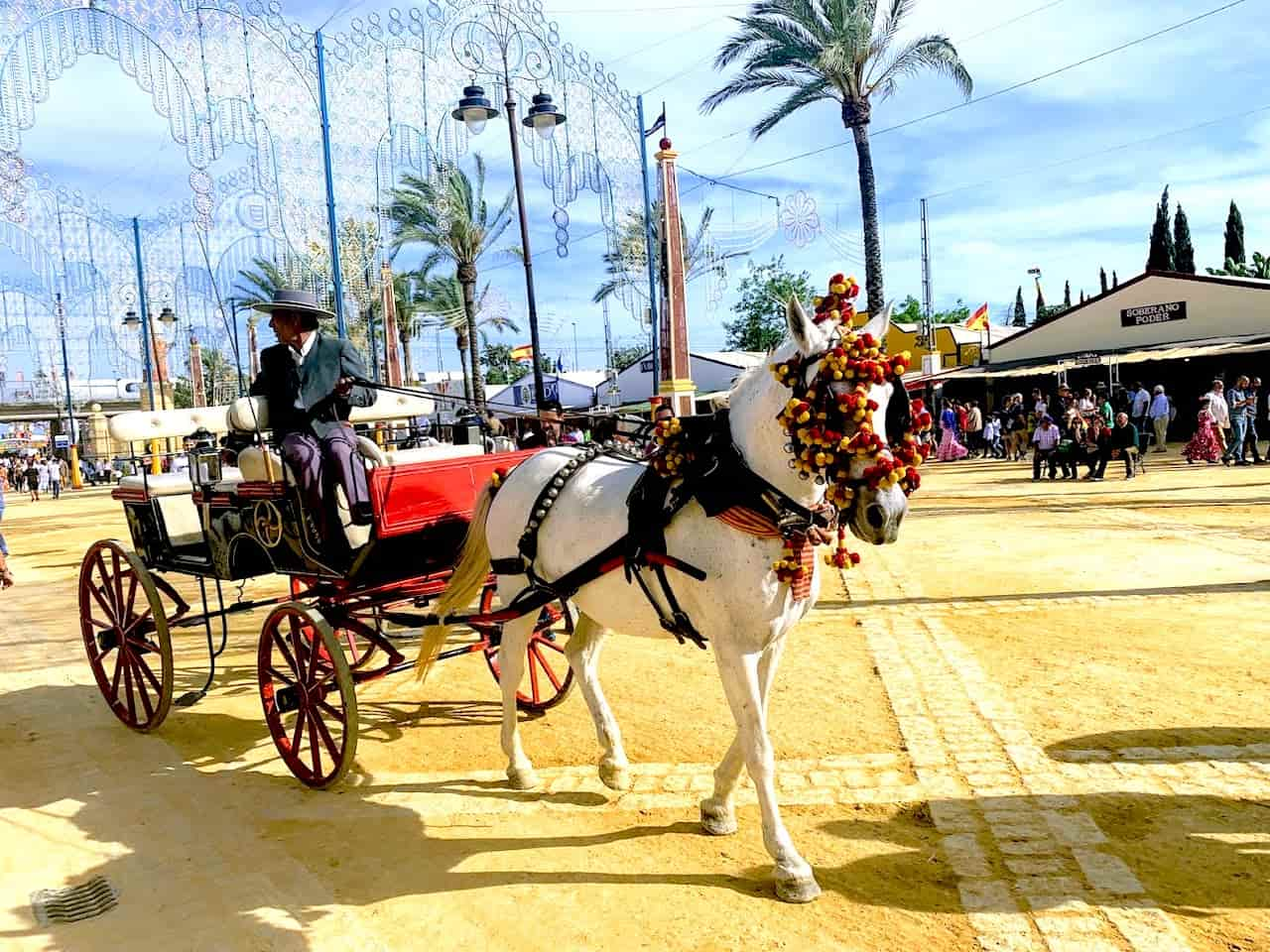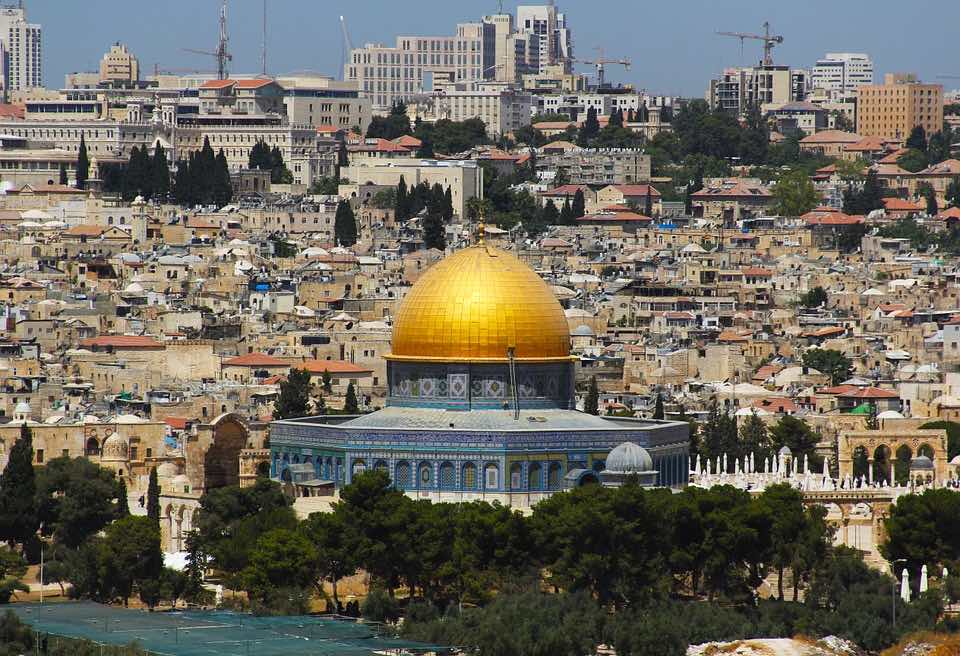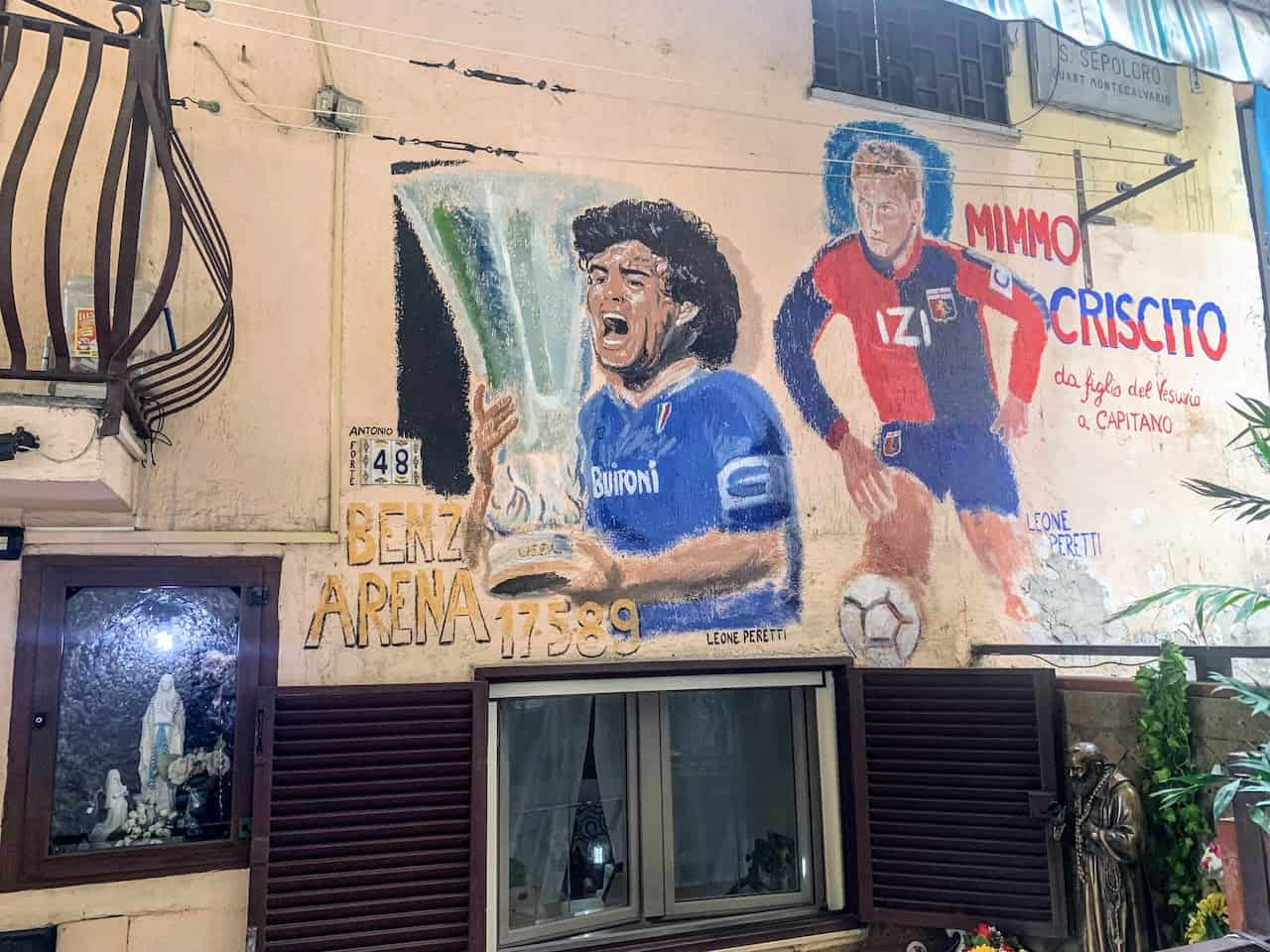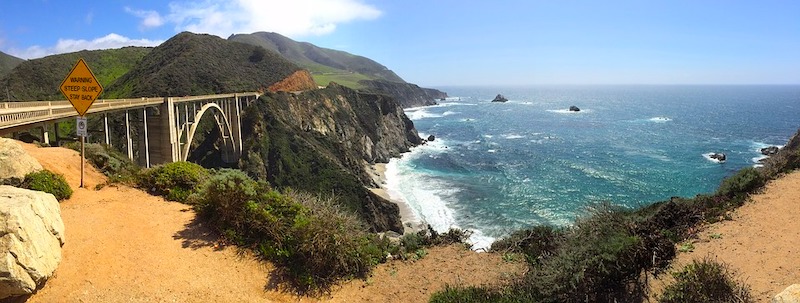Segesta Sicily: Why This Ancient Temple Is the Most Magical Place You’ve Never Heard Of
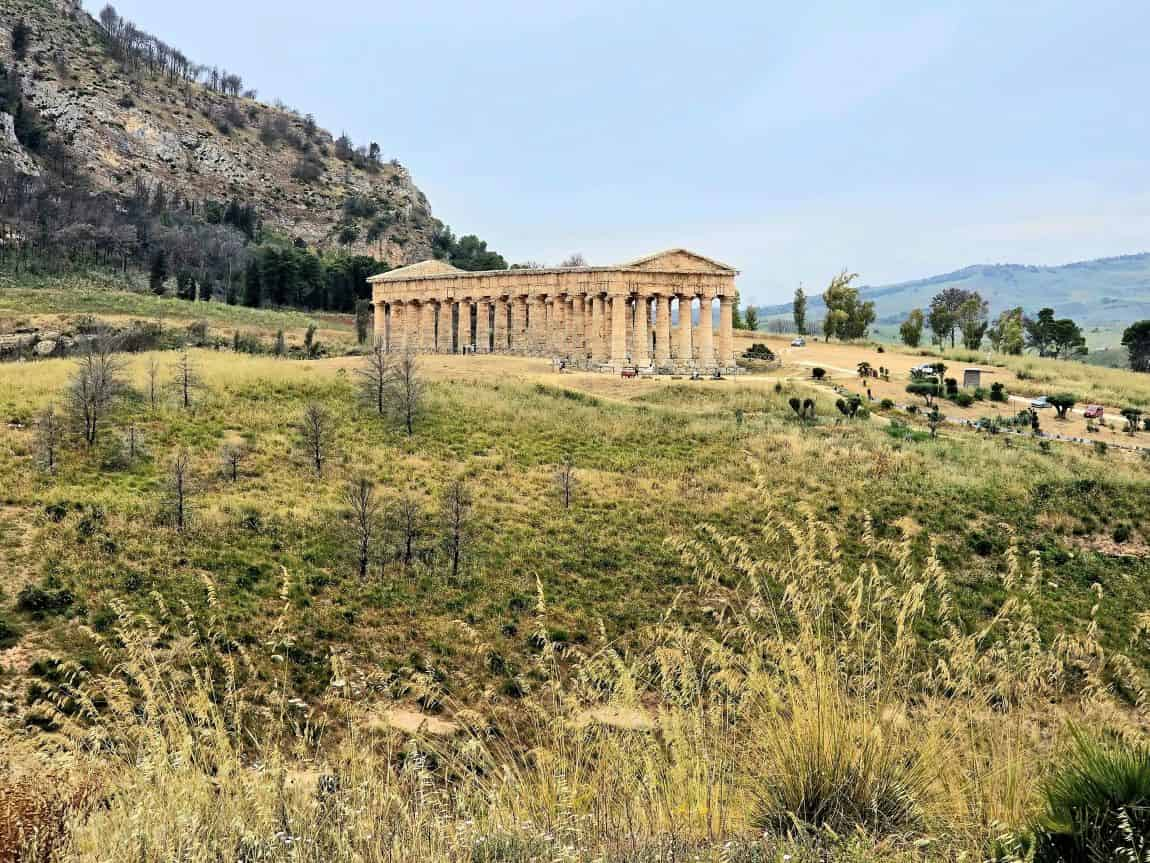
The Ultimate Guide to Visiting Segesta Sicily (2025 Edition) —What to See and How to Visit.
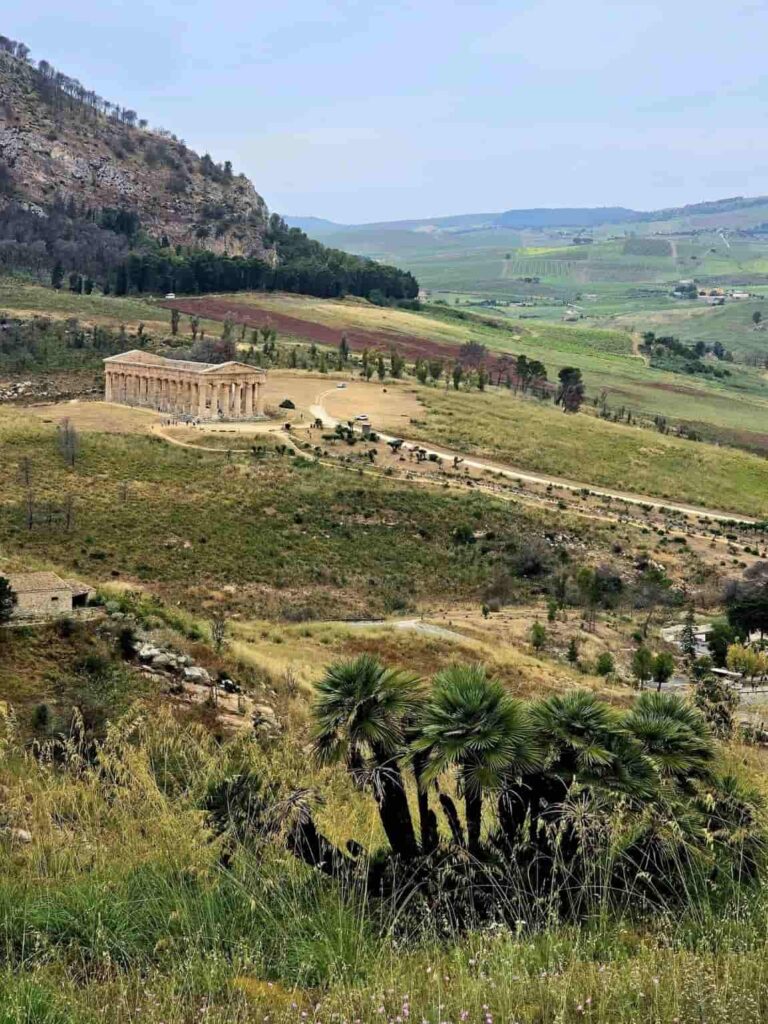
Segesta is one of Sicily’s most breathtaking and underrated archaeological sites—a place where ancient history, myth, and natural beauty come together in perfect harmony. Nestled in the hills between Palermo and Trapani, the Segesta Archaeological Park is an unmissable stop on any western Sicily road trip.
Segesta has always attracted the imagination of travelers, artists, and filmmakers. The legendary German writer Johann Wolfgang von Goethe visited in 1787 during his Italian Journey, marveling at the temple’s harmony with the natural landscape. More recently, its breathtaking scenery and evocative ruins have drawn film directors. Segesta’s ancient theater and temple were featured in the Italian epic “Kaos” by the Taviani brothers, a cinematic adaptation of Pirandello’s Sicilian tales. The park also appeared in several documentaries and international productions that seek to capture the soul of classical antiquity.
I wasn’t expecting to be so moved by a pile of stones on a hilltop, but Segesta proved me wrong. It was a stop on my Sicily road trip, somewhere between the lively energy of Palermo and the coastal charm of Trapani. As I drove through the sunbaked hills of western Sicily, winding past vineyards and olive groves, Segesta emerged—quiet, timeless, and majestic.
Segesta isn’t just a historical site—it’s a living, breathing cultural stage.
If you’re planning a road trip through Sicily (and you absolutely should), Segesta is an essential stop. It offers history without the crowds, beauty without pretension, and a deep, grounding sense of place.
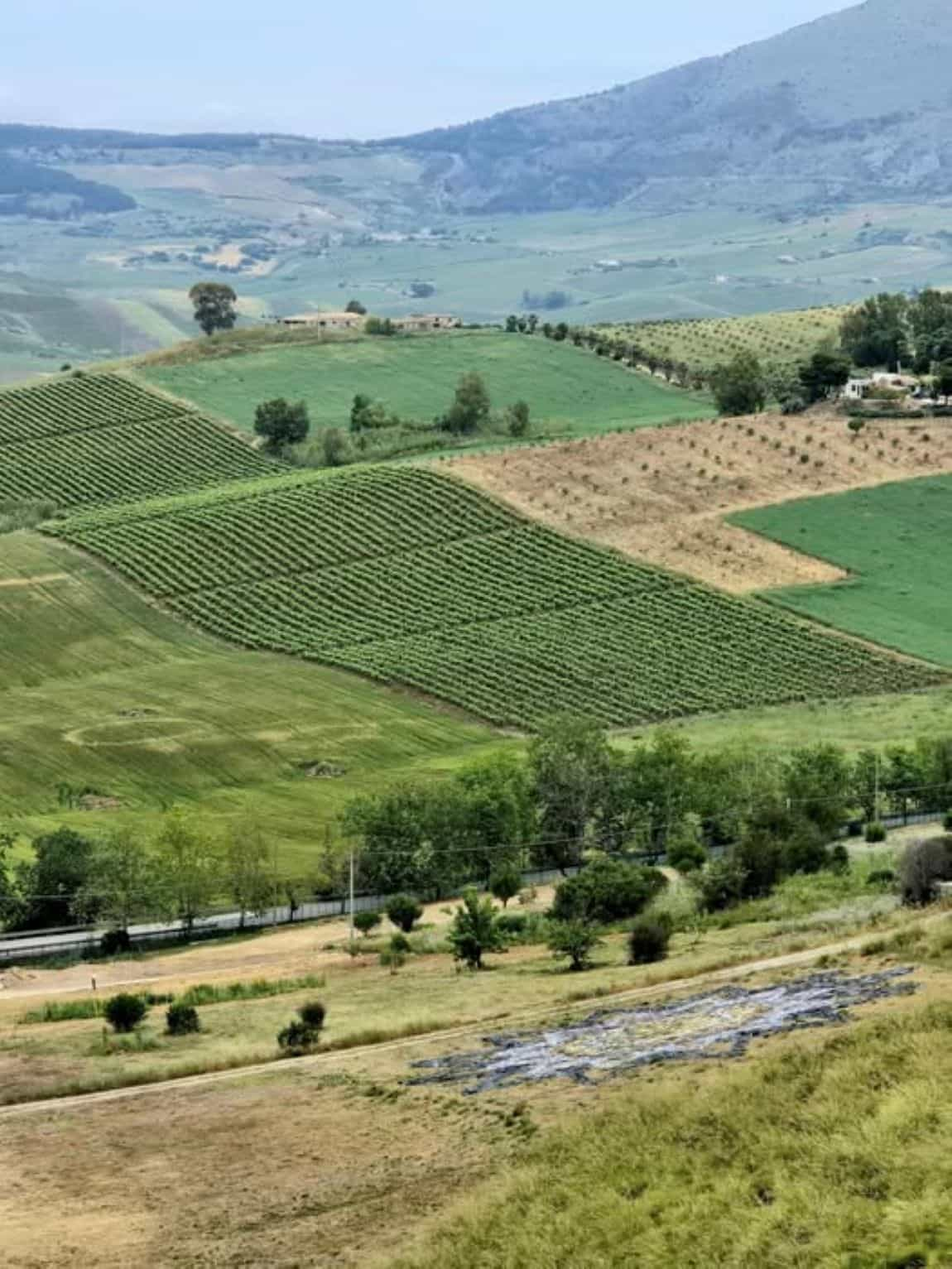
THIS POST MAY CONTAIN COMPENSATED LINKS. PLEASE READ MY DISCLAIMER FOR MORE INFO.
A Short History of Segesta: A City of Myths, Wars, and Shifting Powers
Segesta was founded over 2,500 years ago by the Elymians, a mysterious people who, according to ancient legend, were descended from refugees of the Trojan War and one of the three indigenous peoples of Sicily. Some say they came with Aeneas himself. Whatever their origin, the Elymians carved out a powerful and culturally sophisticated city in the hills of northwestern Sicily.
Unlike their neighbors—Greek colonies like Selinunte or Akragas—the Elymians weren’t Greek, though they were heavily influenced by Greek architecture and customs. Over time, Segesta played a delicate political game, aligning first with Athens against the Greek city of Selinunte, then with Carthage, and eventually with Rome.
Despite never growing into a vast metropolis, Segesta was always strategically important. It controlled key inland trade routes and stood as a cultural crossroads between the Elymian, Greek, Punic, and Roman worlds. Its political history is a story of diplomacy, betrayal, destruction, and survival. Even after wars and invasions, Segesta Sicily remained inhabited well into the Middle Ages, with later additions such as a mosque, a Norman church, and a medieval castle.
Today, the ruins may be quiet, but the landscape is alive with stories.
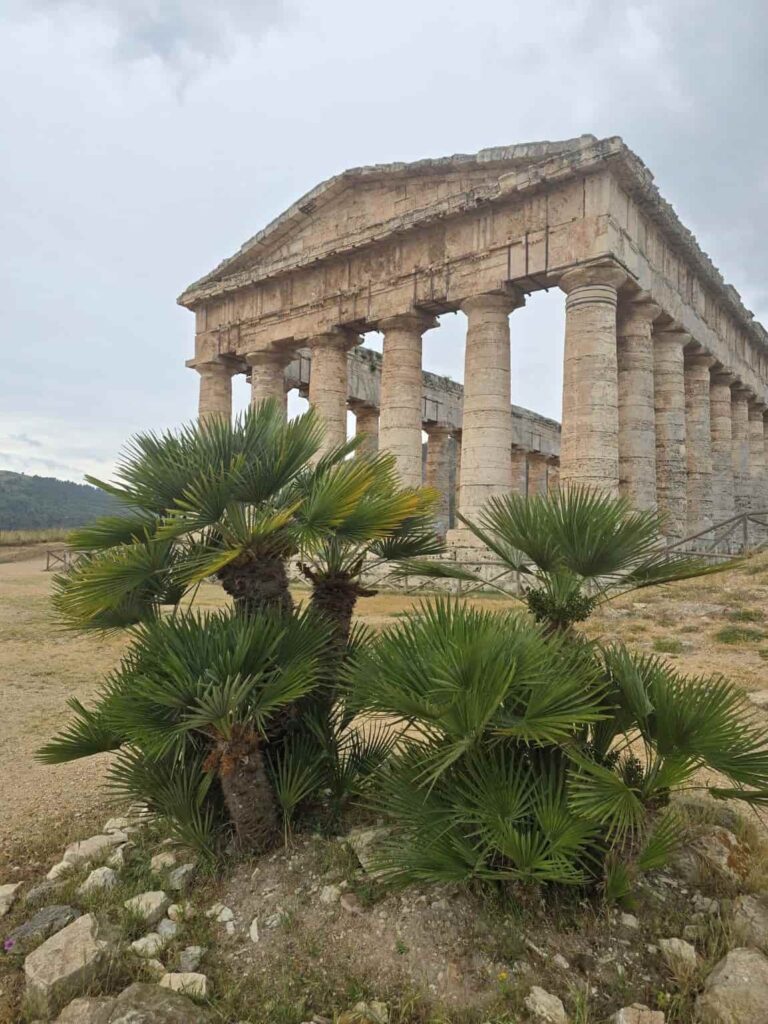
What to See in the Segesta Archeological Park
From its iconic unfinished Doric temple to a hilltop Hellenistic theater with views that stretch to the sea and remnants of later medieval structures, every structure tells a story of ambition, conflict, and cultural fusion. Exploring the park is like walking through the pages of an ancient epic—layered, timeless, and deeply atmospheric.
The Doric Temple Of Segesta
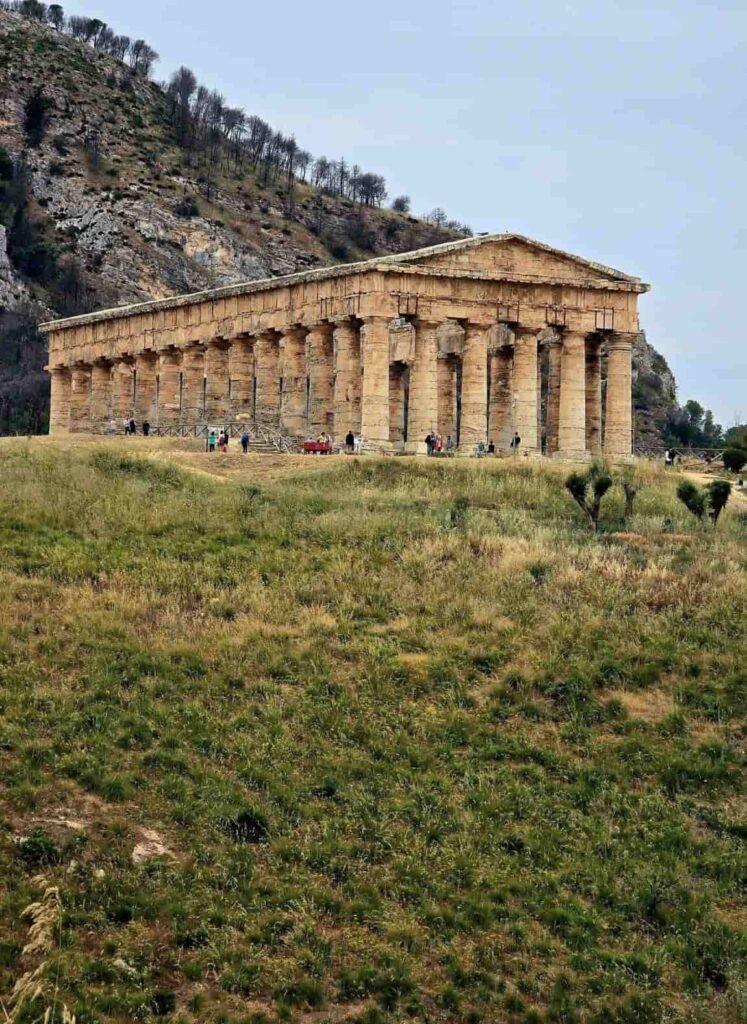
The first thing you’ll see upon entering the park is the Temple of Segesta. It rises on a natural terrace, perfectly framed by rolling hills and big Sicilian skies. There’s something haunting about it—this temple that was never finished.
It was built around 420–430 BCE, during a time when Segesta was trying to assert itself as a major power. The city had just allied with Athens against Selinunte, and this monumental structure was likely part of that campaign—an architectural statement of wealth, influence, and cultural refinement.
Yet the temple was never completed. The columns were left unfluted. There is no inner cella, no roof. The reasons remain uncertain—perhaps war, lack of funds, or political upheaval halted construction. But even in its unfinished state, the temple is extraordinary.
It is built in the Doric style, with six columns across the front and fourteen along the sides. That’s 36 monolithic columns in total, each over 10 meters high. The platform stretches about 61 meters in length and 26 meters in width, making it one of the best-preserved examples of classical architecture in all of Sicily.
What’s truly remarkable is how perfectly it blends with the landscape. You don’t just look at the temple—you feel its presence. It’s elegant, powerful, and deeply harmonious with its surroundings.
The Theater of Segesta
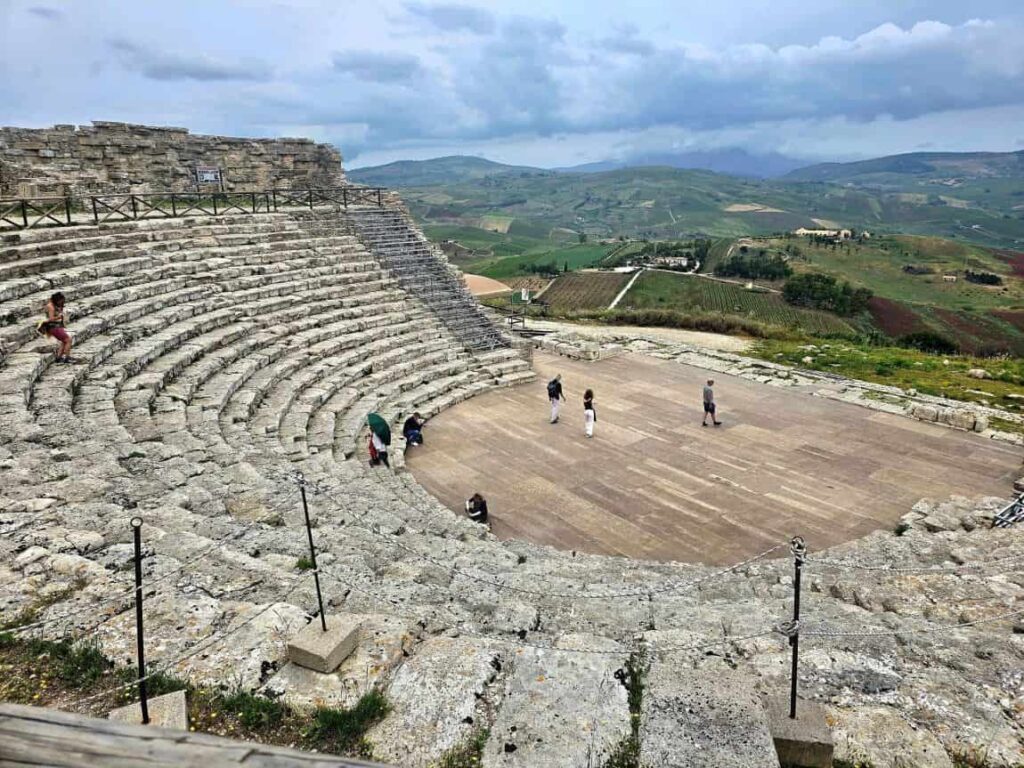
From the temple, the path to the ancient theater leads you higher to the top of Mount Barbaro. You can either walk—though it’s a steep 1.5-kilometer climb—or take the park’s shuttle bus, which departs regularly from the entrance plaza. I recommend riding up and walking back down to enjoy the views.
The theater sits at the top of Mount Barbaro and offers one of the most breathtaking panoramas in all of Sicily. Built in the late 3rd century BCE, during the Hellenistic period, the theater reflects Greek architectural traditions, even though it was later modified under Roman rule.
It could hold around 4,000 spectators and was carved directly into the slope of the mountain. Instead of facing a backdrop of walls or columns, this theater opens up to the horizon. From your seat, you look out over distant hills, the sea in the Gulf of Castelmare in the far distance, and the soft golden fields below.
The orchestra, cavea, and stage area are still largely intact, and during the summer months, the theater comes alive again with open-air performances—ancient plays, concerts, and modern reinterpretations of classical works. If you can time your visit with a performance, it’s unforgettable.
Exploring the Rest of Segesta Archeological Park
Segesta isn’t just about the temple and theater. Scattered across the park are the remains of structures that tell the story of the city’s long and layered history.
The agora, or public square, lies in ruins now, but it once served as the beating heart of civic life in the classical period. Here, citizens debated, traded, and gathered.
As you wander further, you’ll come across the foundations of a mosque, a rare remnant of the Islamic period in Sicily, when Arab rulers controlled much of the island between the 9th and 11th centuries. Not far from it is the simple stone structure of a Norman church, built in the 12th century after the Christian reconquest. Higher still, the medieval castle, built during the Norman or Swabian era, looks out over the valley—a final chapter in the long story of Segesta Sicily.
Each ruin adds another layer to the park’s complex past. Walking from one to the next is like flipping through the pages of a time-worn book.
Getting to Segesta Sicily
Segesta is located in the province of Trapani, in northwestern Sicily. It lies about halfway between Palermo and Trapani, making it an ideal stop on a westward Sicily road trip.
If you’re driving, the route is straightforward. From Palermo, it takes about an hour on the A29 highway. From Trapani, it’s roughly 40 minutes. There’s a large parking lot near the park entrance, with ample space even in high season.
If you’re not driving, guided tours are a great option. Day trips from Palermo and Trapani are easy to find and usually include transport, entrance fees, and sometimes even a live guide or audio tour. Here are some options:
Tour of Erice and Segesta from Palermo,
Day Trip to Erice, Segesta and Salt Pans from Palermo,
Private Day Trip to Segesta, Erice, and Trapani from Palermo,
Segesta and Selinunte full day tour from Trapani
Public transport options exist, but they are limited and require careful planning—so if you’re relying on buses, check schedules thoroughly and consider booking in advance.
Practical Info: Tickets & Opening Times
Tickets to the Segesta Archaeological Park cost €16 for adults (as of 2025), with reduced prices for EU citizens under 25. Children under 18 and some visitors with disabilities may enter for free. A ticket for the park’s shuttle bus is €2. Tickets can be purchased at the entrance or online through the park’s official website and other authorized platforms. Secure your entry ticket in advance here.
Entry is free on the first Sunday of every month, which is a great bonus if you’re timing your visit right.
The park is open daily. From April to October, it opens at 9:00 AM and closes at 7:30 PM, with last admission at 6:30 PM. In the off-season (November to March), it closes earlier, usually around 5:00 PM. Check the website before you go, as times can vary slightly with holidays and weather.
Getting Around Segesta Archeological Park
Segesta is a hillside site, so be prepared for walking. Here’s how to get around:
- From the entrance, the Temple is about a 5-minute walk on a slightly uphill, well-maintained path.
- To reach the Theater and castle ruins, you can either hike uphill (about 20–25 minutes) or take the shuttle bus, which runs regularly and costs a few euros.
- Paths around the park are unpaved and uneven in places—wear sturdy shoes and bring water.
The Best Time to Visit Segesta
While Segesta is open year-round, spring (April to early June) and autumn (September to October) are ideal. The weather is pleasantly warm, wildflowers bloom across the hills in spring, and the golden light makes the ruins glow. I visited Segesta on my Sicily road trip in May. A perfect time —pleasant temperatures and no tourist crowds!
Summer can be scorching—especially around midday—but it’s also the season for open-air performances in the ancient theater. If you can, arrive early in the morning or late in the afternoon for softer light and cooler temperatures.
How Much Time to Spend in Segesta Archeological Park
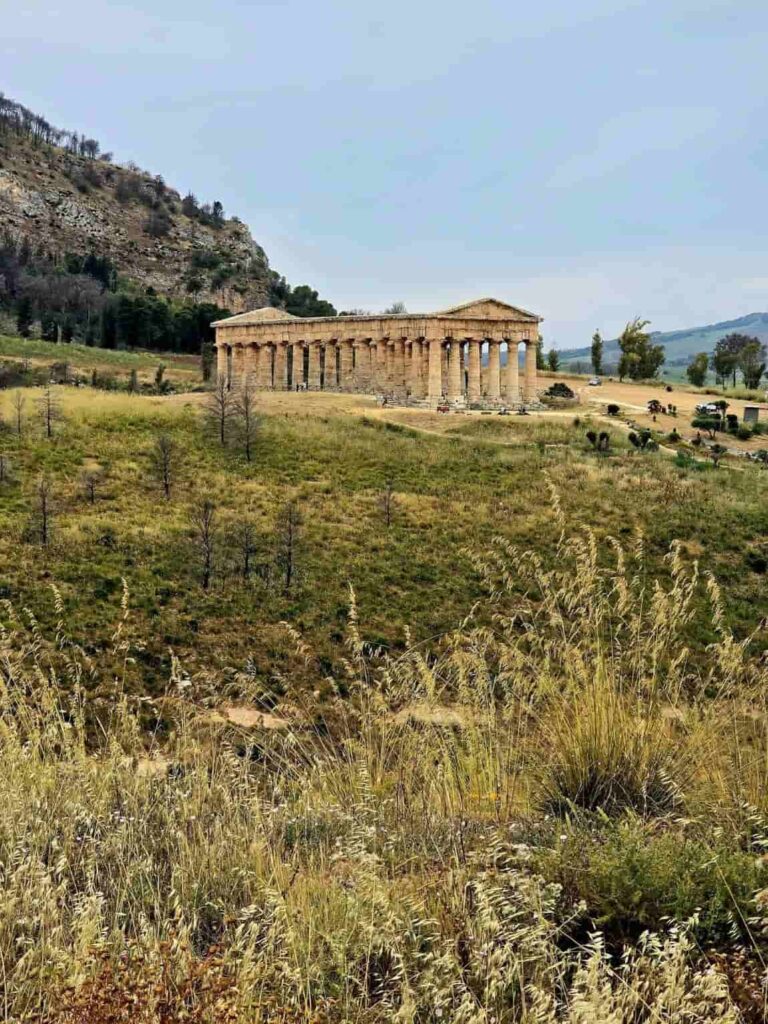
You’ll need 2 to 3 hours to explore the entire park at a relaxed pace. The distance between the temple and the theater is significant, so take the shuttle bus if you’d rather not hike uphill in the heat. The bus departs every 15–20 minutes and costs 2 euros. Comfortable walking shoes, sun protection, and water are essential—especially during the hot summer months.
What’s Nearby Segesta Sicily?
Segesta sits in one of Sicily’s most rewarding regions. Just a short drive away (40 min) is Erice, a hilltop town where stone streets wind past medieval churches and panoramic viewpoints. Head 30 minutes west and you’ll reach Trapani, with its salt pans, historic center, and access to the Egadi Islands. 25 minutes to the northeast is Castellammare del Golfo, a coastal town perfect for seafood lunches and a swim. And if you’re craving nature, the stunning Zingaro Nature Reserve, offering hiking trails and hidden coves along the Mediterranean, is 1 hour and 20 minutes away.
Final Thoughts: Why You Should Visit Segesta Sicily
From its Elymian roots to Greek ambition, Roman legacy, Islamic presence, and Norman stronghold, Segesta is a place where every ruin whispers a story. Unlike more crowded sites, Segesta allows you to explore at your own pace, surrounded by silence, wind, and the open Sicilian landscape.
Segesta is a place where layers of history lie open to the sky, where silence speaks volumes, and where the past is written not in textbooks but in stone. Walking through the park, I felt connected—not only to ancient times, but to the spirit of Sicily itself: complex, beautiful, and eternal.
So if you’re traveling between Palermo and Trapani, don’t just drive past—take the detour, walk among the ruins, and let Segesta’s timeless magic captivate you.
YOU MIGHT ALSO ENJOY:
Selinunte Sicily: The Forgotten Greek City That’s Better Than Agrigento
How to Spend 2 Perfect Days in Palermo, Italy
20 Unforgettable Things to Do in Palermo, Italy
This One-Day Palermo Itinerary Is A Golden Ticket To Experience The Best Of Palermo In 24 Hours!
21 Must-Try Foods in Palermo — Plus the Best Markets, Food Tours & Places to Savor Them!
This Sicily’s Seaside Town Looks Straight Out of a Movie—Here’s What to Do in Cefalù
The 23 Bucket List Things to Do in Taormina, Sicily
- 13 Cave Hotels in Matera Italy You Have to See to Believe - September 27, 2025
- Sleep Beneath Italy’s Fairytale Roofs: Discover the Best Trulli Hotels in Puglia - September 25, 2025
- Sleep Like Italian Royalty: The Best Masserie in Puglia You’ll Never Want to Leave - September 24, 2025

